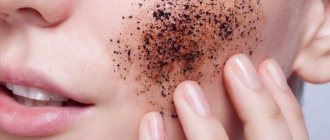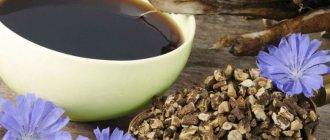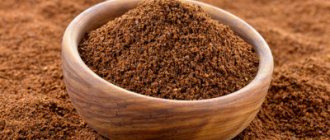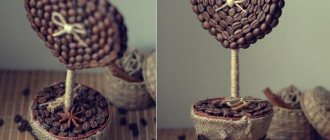The composition of natural coffee changes after brewing; caffeine, organic acids, tannin pass into the water, but most of the beneficial compounds that can be used by plants remain in the grounds. These are nitrogen substances (up to 2%) and minerals (potassium, magnesium phosphorus, iron and calcium), B vitamins, residues of caffeine and its derivatives (up to 6%).
Coffee as fertilizer
Naturally, the effectiveness of coffee cannot be compared with any fast-acting fertilizer, and certainly not a substitute for complex fertilizing. But it is worth recognizing that adding coffee grounds to the soil around plants has a beneficial effect on them.
Decaying organic matter increases the biological activity of the soil. Firstly, it saturates the soil with nitrogen. Secondly, it attracts earthworms, which loosen the soil. Third, coffee used as a fertilizer allows plants to more easily absorb copper, magnesium, potassium and phosphorus from the soil.
Even though coffee contains 2% nitrogen, this does not mean that it can replace a complete nitrogen fertilizer. Since coffee grounds take a long time to decompose, the elements are released slowly.
There is an opinion that coffee significantly increases the acidity of the soil, so it is suitable as a fertilizer only for plants that require a low pH level (conifers, rhododendrons, heathers, etc.). However, this is not quite true. Coffee does “sour”, but only when fresh.
This is interesting:
People, whine less! And help each other more. A letter from a girl who died of cancer at age 27
Sleeping coffee grounds have a neutral reaction - about pH 6.5-6.8 (with an ideal acid-base balance of pH 7). To be sure, it is advisable to rinse the grounds with clean water before using them in the garden.
Using coffee grounds on the farm
There is no need to throw away your coffee. Most often they try to use it as a fertilizer for plants, but all that the grounds can do after getting into a flower pot is to slightly loosen the soil and change its pH in an acidic direction. Only azaleas or gardenias will like this.
We recommend: The best 5-minute breakfasts: 8 recipes for delicious, healthy and satisfying dishes
There are more rational and useful ways to use used (from a coffee machine or Turkish coffee) coffee in everyday life:
- Cleaning dishes. Small and not so small particles of grains are an abrasive that easily removes dried-on food residues or traces left from tea leaves, beets and other coloring products. This method cannot be used for light-colored dishes made of porous materials.
- Elimination of foreign odors from hands. After cleaning fish or chopping garlic, you can rub your palms with fresh coffee grounds and then rinse with warm water.
- Making a toning body scrub. If you mix dried coffee grounds with coarse sugar, add a spoonful of honey and a few drops of orange oil, you will get an excellent remedy for cleansing the skin of dead cells. With constant use, the signs of cellulite decrease and rashes disappear.
- Dyeing of natural fabrics. For this purpose, you need to collect quite a lot of grounds, then brew it in boiling water and place cotton or linen material in the water, leaving it there for several hours. The color will depend on the strength of the decoction and the holding time.
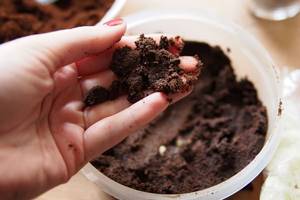
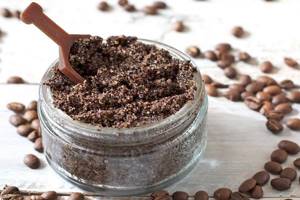
Coffee beans or ground coffee that has expired, as well as dried coffee grounds, should not be thrown into the trash - they can always be used at home, be it for creating crafts, taking care of yourself, or scenting rooms.
Coffee grounds compost
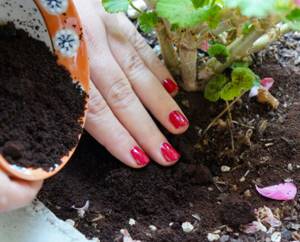
Composting used coffee couldn't be easier - just throw the grounds into the compost heap. Again, given the controversy about its acidity, for greater peace of mind it is advisable to pre-rinse it under running water.
Following the grounds, you can also send paper coffee filters. All this will rot and benefit the plants.
The only important nuance that should be taken into account when composting is the proper selection of compost components. In addition to coffee grounds and other food waste, you need to add more “solid” components to the compost pit: straw, wood debris, manure, grass clippings, etc. Coffee grounds should make up no more than 15-20% of the total compost, otherwise it simply will not rot.
What can be made from coffee beans?
Coffee beans are an ideal material for creativity. They are not harmful to health and do not poison the air with toxins; they are beautiful in themselves, and can be easily painted if necessary. The scope of their application is limited only by imagination.

Painting
Even someone who doesn’t know how to draw can make a picture out of coffee beans. The secret is simple - the image is first printed on a printer, and coffee is glued on top of the paint. In this case, there is no need to cover the entire canvas with grains - they are placed only where there are dark areas. For example, if this is a portrait, then only the hair, eyebrows, eyes, lips and nose are blocked. Where fine lines are needed, it is not practical to use whole grains, so they are crushed with a hammer.

Topiary
Topiary is a small (usually up to 20–30 cm in height) tree made from decorative materials. However, it does not have to have a direct resemblance to a tree - for example, topiaries in the shape of a ball or a heart are often found.
To create it you will need the following tools and materials:
- newspaper or toilet paper;
- a small pot or cup for a stand;
- alabaster and water;
- awl;
- a stick (strong enough to support the weight of the top of the topiary, this could be a kebab skewer);
- decorations - optional (colored beads, ribbons or something else);
- quick-setting glue;
- coffee beans;
- PVA glue;
- glue brush;
- disposable plastic or paper cup.
The work is performed according to the following algorithm:
- A piece of newspaper is crumpled in your hands to form a small ball.
- In a glass, dilute PVA glue in half with water.
- The remaining newspaper is torn to shreds.
- The brush is dipped into a glass with an adhesive solution and a newspaper ball is lubricated, after which scraps of paper are randomly placed on top of the sticky layer. Then the solution is applied again and the ball is covered with paper. This operation is repeated until the ball acquires an almost ideal shape and the desired size. It is recommended to make a ball with a diameter of at least 10 cm.
- The base blank is left to dry. This process may take several days, but it cannot be accelerated by placing the ball on the battery or influencing it in any other way.
- When the ball is ready, it is pierced with an awl and a stick moistened with quick-drying glue is inserted into the resulting hole.
- Next, they begin to decorate the topiary by covering the paper ball with coffee beans. Quick-drying glue is also suitable for this.
- Now it's time to prepare the stand. To do this, alabaster is mixed with water in a 2:1 ratio (per 1 kg of alabaster - 0.5 liters of water; the amount of ingredients should be taken in accordance with the volume of the pot or cup). The result will be a slurry that will begin to thicken in about 5 minutes. Complete hardening will occur after 25–30 minutes, so you need to have time to stick a stick with topiary into the not yet hardened solution and hold it in one position until the alabaster turns into stone.
We recommend: How to properly cook different types of pasta in a saucepan and slow cooker?
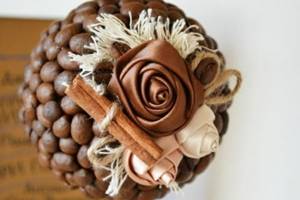
The final stage is decorating the topiary. To disguise alabaster, you can sprinkle coffee beans or colored beads on top of it. The skewer should be braided with ribbons or painted with golden paint. In this case, a pot wrapped in fabric of the same shade will look beautiful.
Stand for pencils or brushes
To make an original stand out of coffee beans, just pour them into a transparent glass container (a vase, an unusual jar, even a small round aquarium will do). In addition to the fact that such a stand will become a decorative item, it will also scent the air in the room. When the smell wears off, you can replace the grains with fresh ones.
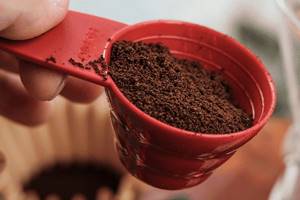
Coffee grounds mulch
Many gardeners use coffee grounds as an environmentally friendly mulch. It is safe for plants, releases nutrients in the soil, enriches it with nitrogen, attracts earthworms, looks natural and is pleasing to the eye.
However, the main disadvantage of such mulch is that it can begin to mold. To prevent this from happening, we again recommend rinsing the grounds with clean water and drying them before spreading them over the soil surface.
This is interesting:
What is your psychological age? Young at heart or...?
Also, if you drink coffee with sugar and milk, naturally they will remain on the coffee grounds. Sweet mulch can attract ants and other insects. Therefore, it is necessary to wash the mass before drying.
Use Cases
To feed plants, it is better not to use too much coffee , otherwise a crust will form on the surface of the earth, which will prevent the free penetration of oxygen to the root system. If the gardener incorrectly calculated the rate of grounds to be added to the soil, this may negatively affect the growth rate.
Experts have developed the three most effective ways to use coffee cake to feed crops:
- The grounds can be scattered evenly around the plant, then watered moderately.
- The cake is dug into the soil at the dacha.
- A solution in which coffee residues are mixed with water has a special effect. This composition can be used to water flowers and trees, as well as the soil for planting seedlings.
The last option is considered the most popular, since nitrogen slowly dissolves in the soil, due to which the plant will receive nutrients for a long time. The first method should be used with extreme caution so that dense crusts do not form around the plants. The thicket perfectly repels snails and ants.
READ ALSO: Proper storage of bee bread
Plants grow much better when coffee residues have been dug directly into the soil. This procedure can be performed in two ways:
- prepare compost to fertilize the soil;
- Before planting, add cake to each hole.
You need to dig in the nutrient mixture very carefully so as not to accidentally damage the roots of the plants. It is better to lay high-quality mulch on top - it will prevent the soil around the crop from drying out.
Soil improver

If the quality of the soil on your site leaves much to be desired (it is too light, or, conversely, not sufficiently air- and moisture-permeable), its structure needs to be improved. Good soil “breathes” and easily allows air and moisture to pass through. To achieve this effect, you can add coffee grounds to the top layer of soil.
Pest barrier
There is an opinion that coffee grounds scattered around plants serve as a reliable barrier against slugs and snails, which can be a real scourge of some crops.
In addition, according to some gardeners, coffee can not only repel, but also destroy the larvae of insect pests, including mosquitoes and bedbugs.
Of course, in the fight against insects dangerous to the crop, you shouldn’t rely solely on coffee, but it won’t hurt to bring it to your side as an additional ally.
This is interesting:
How to properly remember the dead: do not turn Radonitsa into a pagan holiday. Bishop Jonah of Obukhov

